Spring Pruning For Shrubs
Spring is such a beautiful time of year! The birds have come back and are singing, early bulbs lift their cheerful heads, and the newly warming sun entices new leaves to emerge from trees and shrubs. We also feel the energizing pull of spring and the itch to begin pruning becomes strong. But before we just start indiscriminately whacking away at everything because we know we “should” be pruning our plants, it is good to step back, get to know what the plants in your yard need and make a plan.
First, know your plants!
Before you begin any project with your trees and shrubs it is very important to know what your plant is and how your plant naturally wants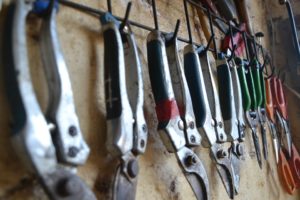 to grow. Armed with this knowledge you can work with your plant’s natural growth habit instead of always fighting against it. You and your plant will be much happier with this approach. So, get out that plant id book or hop on your computer and identify the species you will be pruning. One website for woody landscape plants that is fairly easy to use is https://landscapeplants.oregonstate.edu/ . If you like to use your phone, a couple of great phone apps you can download are PlantNet and iNaturalist. Also, the Sunset Western Garden Book is always a good book to have in your reference library.
to grow. Armed with this knowledge you can work with your plant’s natural growth habit instead of always fighting against it. You and your plant will be much happier with this approach. So, get out that plant id book or hop on your computer and identify the species you will be pruning. One website for woody landscape plants that is fairly easy to use is https://landscapeplants.oregonstate.edu/ . If you like to use your phone, a couple of great phone apps you can download are PlantNet and iNaturalist. Also, the Sunset Western Garden Book is always a good book to have in your reference library.
The questions that you should ask are: What type of pruning would most benefit your plant and when is the best time to take those loppers to it? Is it an early bloomer (spring) or does it provide color later in the year (summer or fall)? Is it a cane grower (Forsythia or Lilac) or more of a woody shrub (has a main trunk that branches out like a Rhododendron)? Will the object of your pruning desire benefit from the type of pruning you have in mind for it?
One determining factor for pruning your shrubs is whether they flower on old wood or new wood. If they bloom in the spring, such as Witch Hazel, Forsythia or Rhododendron, then they bloom on old wood and it would be best to wait until after they bloom to prune them. You can prune them before they bloom, but you may lose out on the flowers for this season. If your shrub blooms later (early summer to fall) such as Mophead or Oakleaf Hydrangeas, Crape myrtle, or Spirea , then it blooms on new wood and late winter/early spring is a great time to prune.
Second, what is your objective for the chosen shrub?
Know why you want to prune! It may be that your plant is fine and will actually benefit from being left alone for a season or more. The questions to ask here are: Do you want to lower the overall height? Does it simply need a little thinning to open up the canopy? Is it a specimen that you want to show off, or have you planted a row of shrubs for a hedge? Is the plant overgrown or getting old and losing vigor? Will a subtle pruning be enough or is something a little more radical necessary to bring it back to good health?
Third, what is your pruning budget?
How much can you remove before you adversely affect your plant's health? A good pruning budget for most plants is to remove no more than 25% of the canopy at one time. If your shrub needs more, know that it may take several seasons to bring your shrub into your desired shape without adversely affecting its ability to adapt. Be patient! Your plant will thank you with healthy growth and renewed vigor. One of the exceptions to this rule is if the plant is a cane grower and is very overgrown, you can take all canes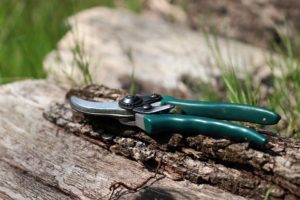 to ground level and “start over”. Cass Turnbull of Plant Amnesty called this type of pruning “radical renovation” and it should only be used when a slower approach isn’t appropriate or if you are applying the technique of coppicing. Coppicing is a very old practice of cutting a multi-stemmed shrub or suckering tree down to ground level, which encourages new shoots to grow rapidly from the base during the growing season. This technique, originally used to provide firewood and fencing materials, can help create good stem color on shrubs such as red-twig dogwoods and some willows, can encourage larger leaves on trees such as Smokebush, and rejuvenate old hedging plants such as some Yews that can take such extreme pruning.
to ground level and “start over”. Cass Turnbull of Plant Amnesty called this type of pruning “radical renovation” and it should only be used when a slower approach isn’t appropriate or if you are applying the technique of coppicing. Coppicing is a very old practice of cutting a multi-stemmed shrub or suckering tree down to ground level, which encourages new shoots to grow rapidly from the base during the growing season. This technique, originally used to provide firewood and fencing materials, can help create good stem color on shrubs such as red-twig dogwoods and some willows, can encourage larger leaves on trees such as Smokebush, and rejuvenate old hedging plants such as some Yews that can take such extreme pruning.
Lastly, do you have the right tools?
Your tools should be clean and sharp. Nice, clean cuts are best for your plant to seal the wounds you will be creating and will also make your job a lot easier. The size of the stem will determine your choice of tool:
⦁ Hand pruners are best for stems that are 1/2” or less in diameter. Use bypass shears, not anvil! Bypass blades overlap to make a clean cut, whereas anvil blades can crush and damage plant tissues.
⦁ Loppers can be used on stems greater than ½” but less than 1” in diameter.
⦁ Pruning saws are the preferred tool for any stem greater than 1” in diameter.
⦁ Hedging shears are best for hedging only.
Types of Shrubs
There are so many different plants that could be discussed on the topic of spring pruning, but let’s dive into a few varieties that tend to get the most questions.
Cane growing shrubs:
“Cane growers” are plants that sprout from the ground to form multi-stemmed woody plants with a naturally free-flowing habit. Examples are: Forsythia (Forsythia spp.), Japanese kerria (Kerria japonica), Mock orange (Philadelphus spp.), Ninebark (Physocarpus spp.), Viburnums (Viburnum spp.), and Weigelia (Weigela spp.).
Please don’t shear them into hedges! A shearing cut is made anywhere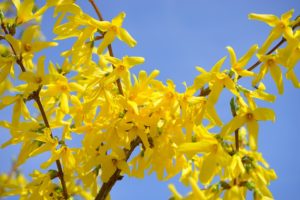 along the length of a plant's stem at a set height or width, without regard to the structure of the plant. Neatly trimmed hedges have a place in formal gardens, but it is not an appropriate approach to most plants. Plants such as boxwoods, laurels, photinia, privet, and arborvitae make great hedges as their growth response is more adaptable to this kind of indiscriminate cutting. However, for most cane growers, this kind of “pruning” will simply rob them of their natural beauty and form. The best way to keep a cane-grower healthy and productive is to periodically thin out old stems just after the flowers fade.
along the length of a plant's stem at a set height or width, without regard to the structure of the plant. Neatly trimmed hedges have a place in formal gardens, but it is not an appropriate approach to most plants. Plants such as boxwoods, laurels, photinia, privet, and arborvitae make great hedges as their growth response is more adaptable to this kind of indiscriminate cutting. However, for most cane growers, this kind of “pruning” will simply rob them of their natural beauty and form. The best way to keep a cane-grower healthy and productive is to periodically thin out old stems just after the flowers fade.
To prune a cane grower, begin by removing three to five of the oldest stems all the way down to ground level. This first step is a good time to remove diseased or damaged stems as well. Next, if needed, remove of few more stems to ground level to allow more light and air to reach the center. Remove these stems in a random and natural-looking pattern. Remember your “budget” and allow most of the stems to remain. Finally, step back and look at your work. At this point, you can remove any stems that seem unappealing or out of place. This type of approach will keep your cane-grower healthy and vigorous for many years to come.
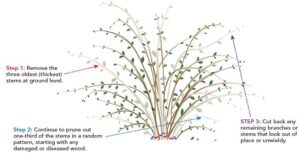 Hydrangeas:
Hydrangeas:
Here is another plant that you should identify before pruning as there are several distinct species that require pruning at different times of the year. Some hydrangeas such as the ‘PeeGee’ (Hydrangea paniculata) and smooth hydrangeas (Hydrangea arborescens) bloom on new wood and can be pruned in winter or early spring. Other hydrangeas such as the ‘Big-leaf’ (Hydrangea macrophylla) and ‘Oakleaf’ (Hydrangea quercifolia) bloom on old wood and should be pruned after the plant finishes flowering in the summer.
Hydrangeas, honestly, do not need regular pruning. They will grow and flower well with very little input other than to remove spent flowers and deadwood. However, they do need tidying and rejuvenating from time to time. Hydrangeas that bloom on old wood generally do not need pruning other than to clean up old blooms if you find them unsightly. Instead, site these varieties in an area where they can “just be” or choose a variety that will not get too big for its chosen space. Hydrangeas that bloom on new wood can be pruned just as the new growth is beginning to emerge in spring. Treat these as you would any cane grower above.
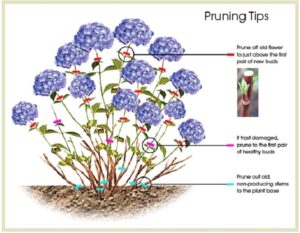 Roses:
Roses:
You can get as many opinions on how and when to prune roses as there are passionate gardeners out there. This topic is always good for a lively debate! Similar to hydrangeas, it is good to know the type of rose you have as that will influence when and how much you prune. But, with that said, there are some basic pruning fundamentals that apply to most roses in order to keep them healthy and happy.
In the summer, deadheading spent blooms will generally encourage more blooms. In fall, after the first major frost has passed, is a good time to clean up any leftover spent flowers, remove diseased or dead branches, and clean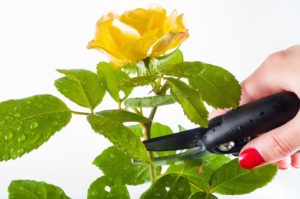 up the leaves to prevent the spread of diseases. This is not the time for a “hard prune”! Take it easy as too much pruning at this time can stimulate growth that can be damaged by winter weather. Spring is, in general, the best time for any major pruning. Prune after the last frost of the season. For us in the PNW that is usually around early to mid-April on average. Take out any crossing branches and a few of the oldest canes, entirely remove any thin or weak growth and suckers, and, if desired, lower the remaining canes. The goal is to have an open structured plant that resembles a nice vase shape. Cut the stems about ¼ inch above an outward-facing bud above a five to seven-leaflet leaf. The cut should slant away from the bud to keep water from standing in the bud union. Climbers are the exception to the general vase-shape rule as you would train these canes to a trellis or maybe a fence line instead.
up the leaves to prevent the spread of diseases. This is not the time for a “hard prune”! Take it easy as too much pruning at this time can stimulate growth that can be damaged by winter weather. Spring is, in general, the best time for any major pruning. Prune after the last frost of the season. For us in the PNW that is usually around early to mid-April on average. Take out any crossing branches and a few of the oldest canes, entirely remove any thin or weak growth and suckers, and, if desired, lower the remaining canes. The goal is to have an open structured plant that resembles a nice vase shape. Cut the stems about ¼ inch above an outward-facing bud above a five to seven-leaflet leaf. The cut should slant away from the bud to keep water from standing in the bud union. Climbers are the exception to the general vase-shape rule as you would train these canes to a trellis or maybe a fence line instead.
Best time to remove Suckers and water sprouts on trees and shrubs:
Suckers and water sprouts are unproductive shoots off the main stem or trunk. Suckers are shoots that arise from below ground or ground level as opposed to water sprouts which are found growing off of the canopy branches. While this type of growth is most commonly found on fruit trees (both fruiting and ornamental), they can also be found on plants such as Forsythia, Smokebush, and lilacs.
A common misnomer is that this type of growth should be removed in the spring. However, this is one of those times when it is best to wait until early summer. If you remove these shoots to early, they will grow back with a vengeance creating a lot more work for you in the future. If pruned off after the spring growing push, the plant will respond with fewer suckers and sprouts to remove the following season.
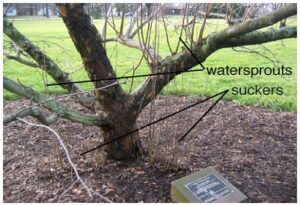 To conclude, spring is such a wonderful, hopeful time of year. Knowing your plants, learning their needs, and working with their natural growth habits will help you in making appropriate pruning decisions. Not only will your shrubs be happy for your efforts, but they will also reward you with healthy vigorous growth and a beautiful display of flowers for years to come.
To conclude, spring is such a wonderful, hopeful time of year. Knowing your plants, learning their needs, and working with their natural growth habits will help you in making appropriate pruning decisions. Not only will your shrubs be happy for your efforts, but they will also reward you with healthy vigorous growth and a beautiful display of flowers for years to come.
Written by Debra Dill.
Debra is an ISA Certified Arborist and has worked in the Horticulture field for 26 years.
She is employed by the Edmonds Parks Department as a field arborist.
She also serves on the Edmonds in Bloom Board of Directors
Do you have questions or comments on spring shrub pruning? Put them in the comments below!
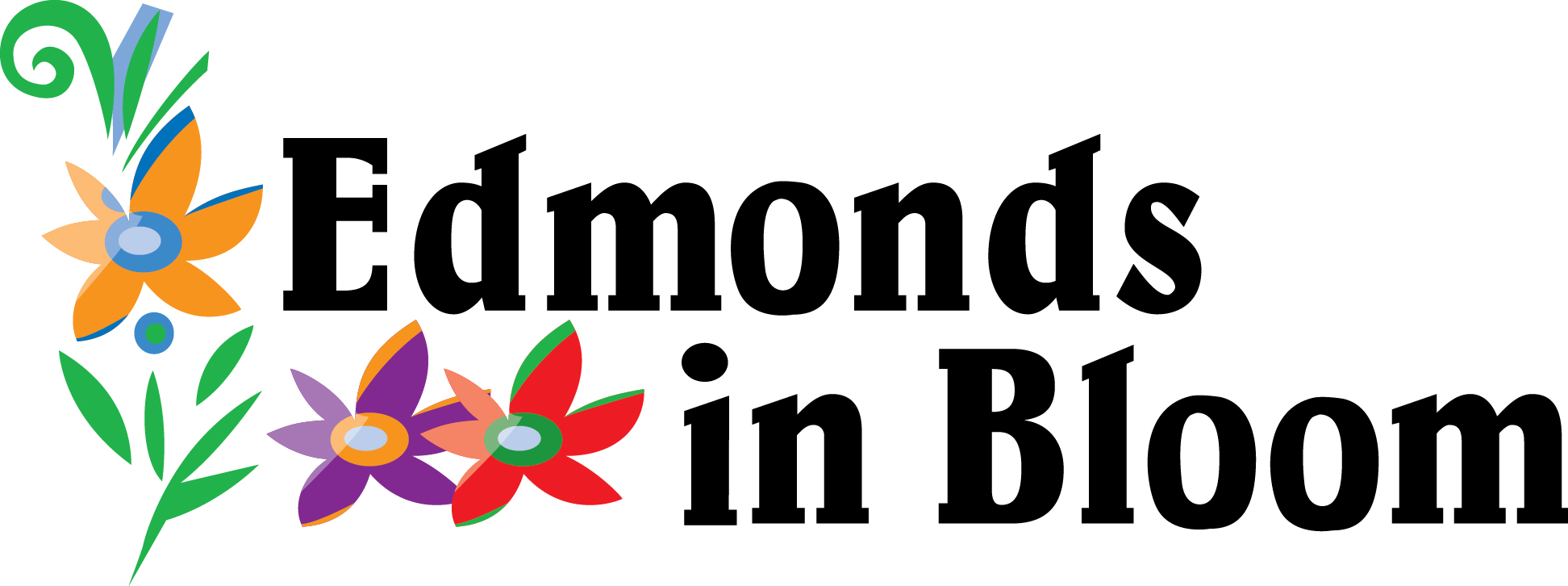

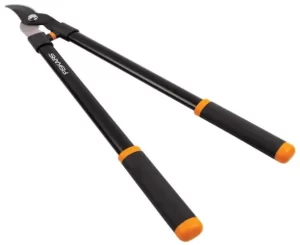
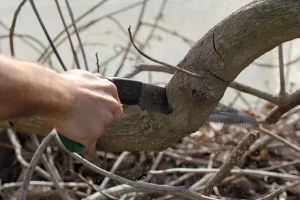
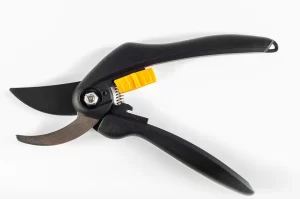
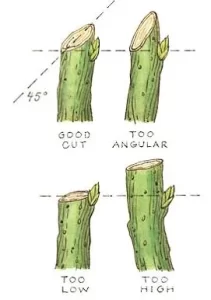

Thank you. You answered many of my questions!